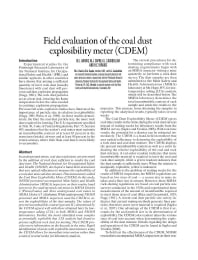Mining Publication: Field Evaluation of the Coal Dust Explosibility Meter
Original creation date: October 2008
Authors: ML Harris, MJ Sapko, KL Cashdollar, HC Verakis
In underground mines, coal dust explosions are prevented by the addition of rock dust sufficient to render the coal dust inert. The National Institute for Occupational Safety and Health (NIOSH) developed a hand-held instrument that uses optical reflectance to measure the explosibility of a rock dust and coal dust mixture. This instrument is called the Coal Dust Explosibility Meter (CDEM). In this study, NIOSH personnel accompanied Mine Safety and Health Administration (MSHA) inspectors on their routine band surveys in five underground coal mines in MSHA District 2 (PA) and three underground coal mines in MSHA District 11 (AL). While underground, NIOSH personnel and MSHA inspectors used the CDEM to assess the explosibilities of the dust samples. The values of percent incombustible content (% IC) determined by the CDEM agreed well with those obtained later by low-temperature ashing (LTA) in both MSHA and NIOSH laboratories. Further, the meter identified some samples as potentially explosible that LTA analysis had found to possess sufficient rock dust for inerting. The CDEM provides more information on the hazards in the mine. Rapid identification of areas with explosible dust mixtures using the CDEM allows for immediate intervention rather than a wait of several weeks for laboratory analysis.

- Coal Dust Explosibility
- Coal Dust Explosibility Meter Evaluation and Recommendations for Application
- How Does Limestone Rock Dust Prevent Coal Dust Explosions in Coal Mines?
- How to use the Coal Dust Explosibility Meter
- Mitigating Coal Dust Explosions in Modern Underground Coal Mines
- Recommendations for a New Rock Dusting Standard to Prevent Coal Dust Explosions in Intake Airways
- Rock Dusting
- Rock Dusting Considerations in Underground Coal Mines
- Technical Development of the Coal Dust Explosibility Meter
- Technology for Real-Time Monitoring of Coal Dust Explosion Hazards
- Technology News 515 - Float Coal Dust Explosion Hazards